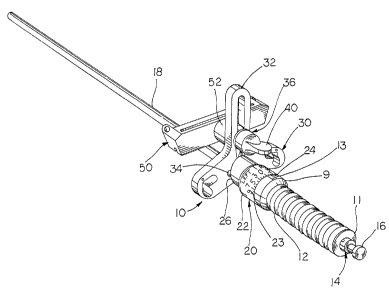Une partie des informations de ce site Web a été fournie par des sources externes. Le gouvernement du Canada n'assume aucune responsabilité concernant la précision, l'actualité ou la fiabilité des informations fournies par les sources externes. Les utilisateurs qui désirent employer cette information devraient consulter directement la source des informations. Le contenu fourni par les sources externes n'est pas assujetti aux exigences sur les langues officielles, la protection des renseignements personnels et l'accessibilité.
L'apparition de différences dans le texte et l'image des Revendications et de l'Abrégé dépend du moment auquel le document est publié. Les textes des Revendications et de l'Abrégé sont affichés :
| (12) Brevet: | (11) CA 2152768 |
|---|---|
| (54) Titre français: | GUIDE D'ALIGNEMENT POUR CHIRURGIE ORTHOPEDIQUE |
| (54) Titre anglais: | ALIGNMENT GUIDE FOR USE IN ORTHOPAEDIC SURGERY |
| Statut: | Réputé périmé |
| (51) Classification internationale des brevets (CIB): |
|
|---|---|
| (72) Inventeurs : |
|
| (73) Titulaires : |
|
| (71) Demandeurs : |
|
| (74) Agent: | GOWLING WLG (CANADA) LLP |
| (74) Co-agent: | |
| (45) Délivré: | 2005-08-30 |
| (22) Date de dépôt: | 1995-06-27 |
| (41) Mise à la disponibilité du public: | 1995-12-28 |
| Requête d'examen: | 2002-06-13 |
| Licence disponible: | S.O. |
| (25) Langue des documents déposés: | Anglais |
| Traité de coopération en matière de brevets (PCT): | Non |
|---|
| (30) Données de priorité de la demande: | ||||||
|---|---|---|---|---|---|---|
|
Le guide d'alignement de cette invention comprend une came rotative autour de l'axe longitudinal du guide d'alignement tel que défini par une tige intramédullaire. Une plaque de base est raccordée en pivot à la tige intramédullaire et comprend deux galets sur les côtés opposés de la tige intramédullaire. En utilisation, comme la came pivote autour de la tige, les galets se déplacent contre la came et font ainsi pivoter ou former un angle par rapport à la plaque par rapport à la tige. Une pluralité d'indices est formée sur la came pour indiquer au chirurgien l'angle relatif entre la plaque et la tige. La plaque de base comprend un mécanisme de fixation rapide permettant au chirurgien de fixer rapidement un périphérique tel qu'un guide de coupe ou un guide de tige à la plaque de base. Le guide de coupe est fixe par rapport à la plaque de base de manière à ce que le guide de coupe soit orienté en angle de la même manière que la plaque par rapport à la tige intramédullaire.
The alignment guide of this invention includes a cam rotatable about the longitudinal axis of the alignment guide as defined by an intramedullary rod. A base plate is pivotally connected to the intramedullary rod and includes a pair of cam followers positioned on opposite sides of the intramedullary rod. In use, as the cam is rotated relative to the rod, the cam followers ride against the cam causing the plate to pivot or angulate relative to the rod. A plurality of indicia are formed on the cam to indicate to the surgeon the relative angle between the plate and the rod. The base plate includes a quick connect mechanism to permit the surgeon to quickly attach a device such as a cutting guide or pinning guide to the base plate. The cutting guide is fixed relative to the base plate such that the cutting guide will be at the same angular orientation as the plate relative to the intramedullary rod.
Note : Les revendications sont présentées dans la langue officielle dans laquelle elles ont été soumises.
Note : Les descriptions sont présentées dans la langue officielle dans laquelle elles ont été soumises.

Pour une meilleure compréhension de l'état de la demande ou brevet qui figure sur cette page, la rubrique Mise en garde , et les descriptions de Brevet , États administratifs , Taxes périodiques et Historique des paiements devraient être consultées.
| Titre | Date |
|---|---|
| Date de délivrance prévu | 2005-08-30 |
| (22) Dépôt | 1995-06-27 |
| (41) Mise à la disponibilité du public | 1995-12-28 |
| Requête d'examen | 2002-06-13 |
| (45) Délivré | 2005-08-30 |
| Réputé périmé | 2015-06-29 |
Il n'y a pas d'historique d'abandonnement
Les titulaires actuels et antérieures au dossier sont affichés en ordre alphabétique.
| Titulaires actuels au dossier |
|---|
| BURKE, DENNIS W. |
| PETERSEN, THOMAS |
| BRISTOL-MYERS SQUIBB COMPANY |
| Titulaires antérieures au dossier |
|---|
| BAYS, RODNEY L. |
| KRUEGER, DAVID |